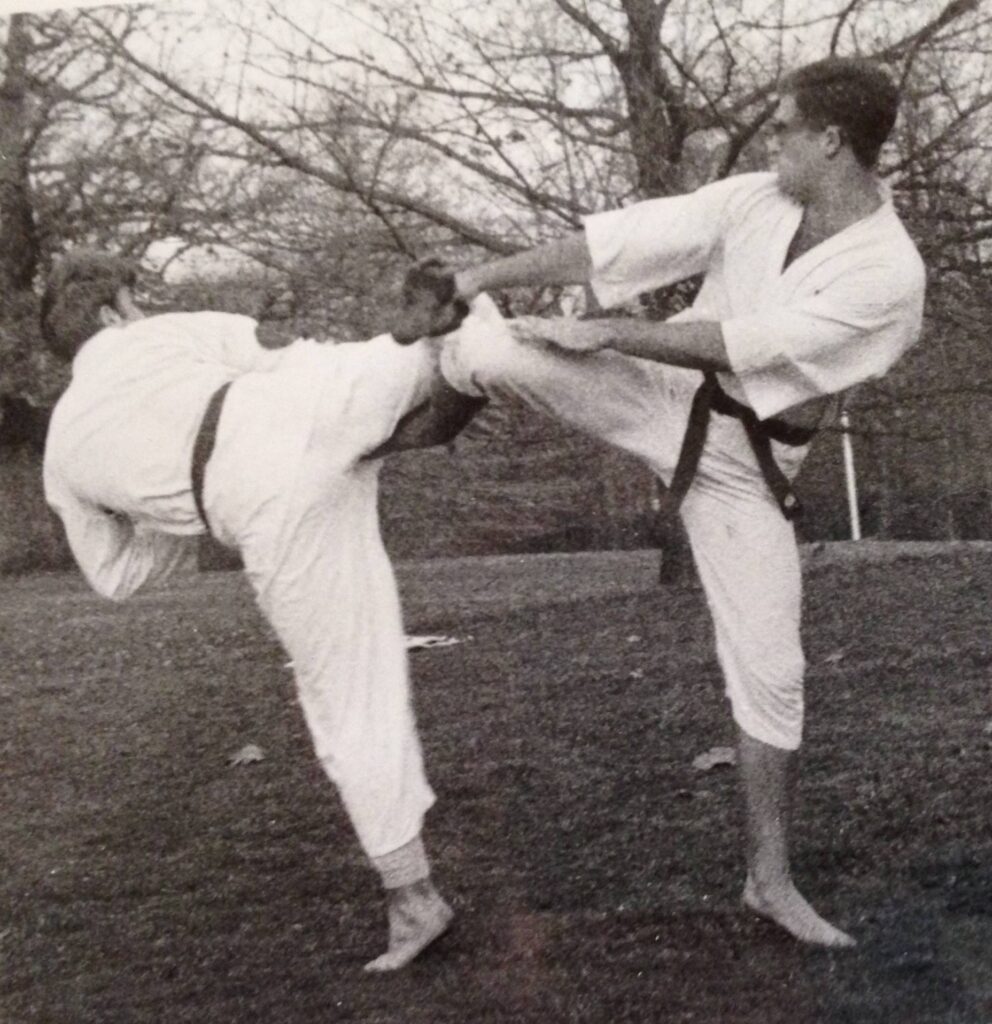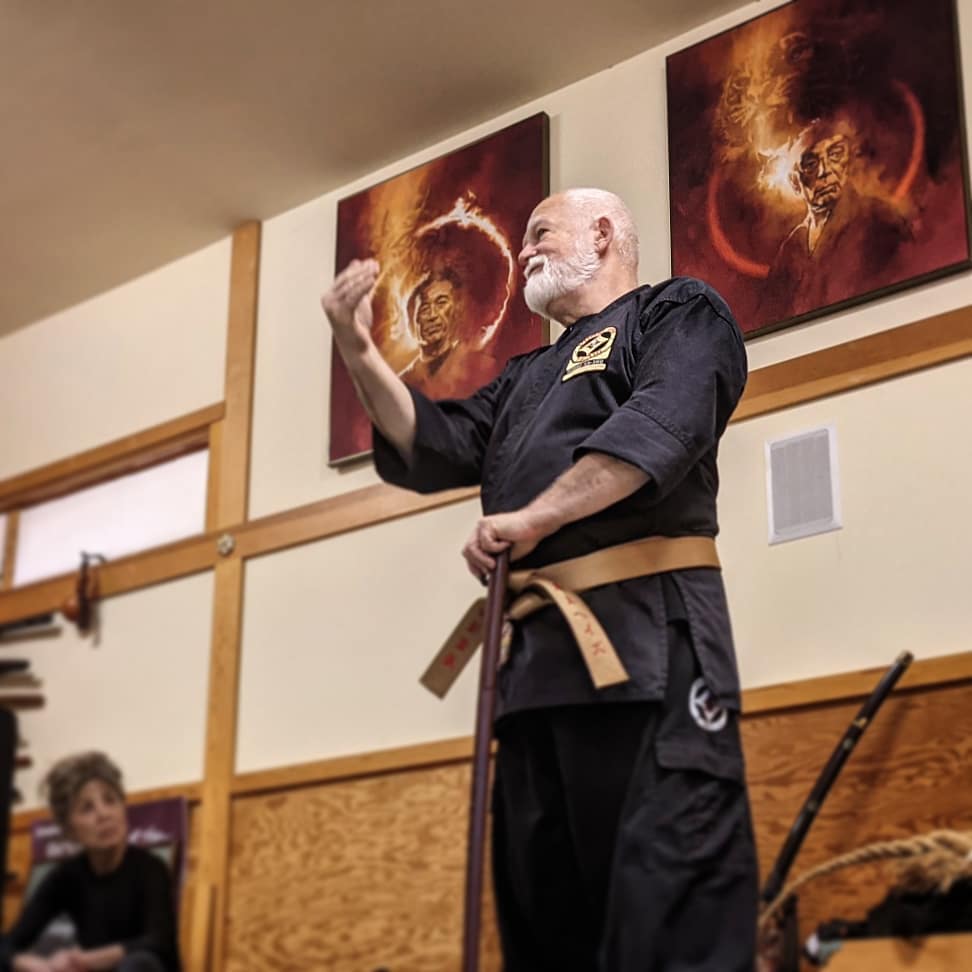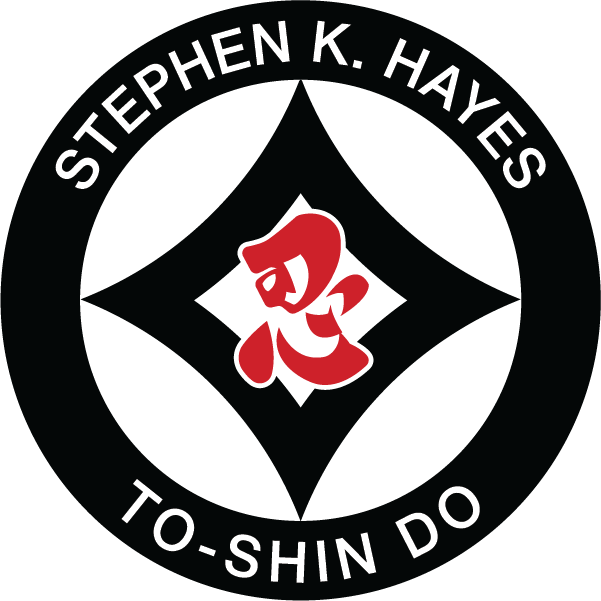ABOUT
Stephen's Quest
Even as a small child Stephen was fascinated with the martial arts and their promise of the ability to protect people from violence. He got his start in sport martial arts as a young man but knew there had to be something more. In 1975 he took a leap of faith and travelled half-way around the world to Japan…looking for the ninja.
By a miraculous turn of events—he found them! After years of rigorous training with Masaaki Hatsumi, Stephen built a reputation as an expert practitioner of ninjutsu. He authored numerous books on the subject, taught seminars around the world, and was featured in countless martial arts magazines as the man who brought the ninja martial arts to the West.
Stephen (still focused on the power to protect) believed that what he had learned could be highly effective for modern self-defense, if practitioners chose to prioritize realism and stayed open to continually adapting and updating their training.
Stephen also realized that physical protection was only half (or less) of the picture. So, in the late 1980s (while continuing to teach martial arts), he set-off on another quest to explore the mind-science and spiritual arts of the ninja in depth, especially the mysterious five element system that his teachers had occasionally mentioned. His quest took him through esoteric mountain training in Japan with the Mikkyo and Shugendo traditions, eventually leading him to the roots of those practices in India and the mountains of Tibet. (He even worked in the 90s as a bodyguard for the Dalai Lama).
In 1997 he decided to weave all of these threads of his quest together and created a new approach to ninja training: To-Shin Do, which combined his passion for effective, adaptable self-defense with his research into the five element system and other time-tested methods of self-understanding. His years of experience writing and teaching allowed him to craft an intelligent training system that is both accessible and transformative.
The To-Shin Do community now has schools on four continents and practitioners all over the world on their own quest to build their protector skills and create a brighter future for all people.
To-Shin Do Online
Find a To-Shin Do school near you, check out upcoming training seminars with Stephen K. Hayes and other top instructors, or BECOME A MEMBER of our online Global Dojo to access our extensive library of video courses (including all Stephen K. Hayes DVD & VHS publications), plus private community, coaching, and testing for remote students!
1949 - 1975
THE NINJA DREAM
Stephen K. Hayes was born on September 9, 1949, in Delaware and grew up in Ohio. Even as a young child, he remembers wishing he had the power to stop bullies and protect people—just like his favorite TV heroes. He was so determined to learn martial arts that he convinced his mother to check out books on the subject from the library after the librarian had refused him, thinking the topic was inappropriate for kids!
His obsession only deepened as he grew. In high school study hall, he first heard about the ninja in a James Bond novel, and when it came time to choose a college, he picked one primarily because he thought it had a Judo club. (That club turned out to be an ROTC Tang Soo Do program—but he persuaded the instructor to let him join, despite not being in ROTC.)
He was finally studying martial arts! Stephen trained diligently, eventually earning several degrees of black belt in Tang Soo Do.
After college, he opened his own martial arts school, but deep down he knew there was more. The sport martial art he was practicing wasn’t enough to satisfy his questions about finding the most effective way of protecting people from real violence.
He couldn’t shake his ninja dream.

1975 -
THE NINJA REALITY
In 1975, with no connections in Japan, no visa, and little money—Stephen took a break from his school and followed his dream to Noda City, Japan, where, by miraculous circumstances, he was able to meet Masaaki Hatsumi, the 34th generation headmaster of the Togakure Ryu school of ninjutsu.
After a brief initial visit, Stephen was able to obtain a rare cultural visa that allowed him to return and stay in Japan for 5 years. He trained tirelessly, learning everything he could about the ninja approach to combat, weapons, espionage, and escape—as well as methods of building mental and spiritual power.
To make a living in Japan he worked in film and TV (and even had a part in the original Shogun miniseries). He also took a job with Canon making instructional videos in English for their products. It was there, in 1979, that he met his match in Rumiko Urata, a woman who grew up in a fishing village on the coast of Kyūshū. It was love at first sight, but Stephen worried what Rumiko would think if she knew why he was really in Japan…
But Rumiko had already discovered his secret and had a ninja dream of her own!
1980 -
THE NINJA AMBASSADORS
Rumiko joined Stephen at the dojo with Masaaki Hatsumi and played a key role in translating historical documents and arcane records about the ninja’s lineage and legacy.
Stephen started writing books and to everyone’s surprise (and his publisher’s delight) Stephen’s books flew off the shelves! For the first time in the West, the ninja became a public icon. Hollywood made movies. There were Ninja Turtles. Shinobi video games. The small dojo in quiet Noda City was about to become a destination for tens of thousands of aspiring martial artists from around the world!
Stephen and Rumiko married and moved back to the United States in the early 80s, but returned to Japan frequently for on-going training. Due to the success of his books and his reputation as an effective teacher, Stephen K. Hayes became a regular face on the cover of martial arts magazines and was in high-demand for seminars and events around the world. Hatsumi encouraged Stephen and Rumiko to, like the ninja, be adaptable and find the best ways to share ninjutsu with students in the West.
By 1990 Stephen had written more then ten best-selling books on every aspect of the ninja methods and spirit! As of today, he’s written more than twenty! His titles, collectively, have sold over a million copies worldwide and have been translated into many languages.
1990 -
THE SPIRITUAL QUEST
But, true to his nature, Stephen always had a next question. He knew that true protector power required more than mastery of violence and confrontation. He wanted his martial arts practice to have a spiritual foundation strong enough to create a better world, not just survive the world we have now.
In 1987, Stephen took initiation into a Japanese mountain-mysticism tradition called Shugendo, seeking to better understand the spiritual roots that supported the ninja’s power and purpose. He received the title Dai-Sendatsu, guide for others on the path of transformation.
That same drive led him into deeper study of the five elements—earth, water, fire, wind, and void—which would become a cornerstone of his martial arts methodology.
His quest took him beyond Japan, to the temples and teachings of esoteric Buddhism in India and Tibet. He studied with respected masters such as His Holiness the Dalai Lama, whom he also served by assisting and advising his security detail during trips to the US in the 90s. Stephen took Bodhisattva vows with His Holiness in 1999.
Additionally, Stephen studied and took further initiations with revered lineage holders of Vajrakilaya and Phurba teachings. And, with his teachers’ help and encouragement, he gladly put in the time and effort to expand access to these traditions by creating new English translations of important practices—translations informed by his deep understanding of the tone, rhythm, and purpose of the rituals.
FOUNDING TO-SHIN DO, 1997
An Elemental Question
After decades of training, teaching, and spiritual exploration, Stephen K. Hayes could see that while the time-tested, fundamental principles of ninpo taijutsu remained profoundly effective—that students needed to experience these principles within the context of their lives, their culture, and the specific threats they were facing.
And, the thing is—culture changes. The threats change. Our lives and our bodies change. The dream, of course, is to become a master—so fluent in the art of balance and escape that it doesn’t matter if your attacker is a sword-wielding samurai, a hard-hitting boxer, or John Wick with a gun. But don’t students deserve to be given the best possible shot at survival on their way to mastery?
Stephen wondered what it would be like if your first year of training covered the twelve most likely attacks handled by the twelve intelligent defenses that you’re most likely to pull off as someone who has only been training for a year!
That’s not to say that he wanted to discard traditional ninja weapons and historical kata—he saw these as invaluable training tools, offering students a meaningful connection to the roots of their art and another avenue for exploring body mechanics, timing, and alignment.
Furthermore, where other styles encouraged students to, as quickly as possible, learn how to turn fear into aggression or, ideally, into masterful (and unlikely) calm in the face of danger. Stephen had spent years intensively studying the five elemental states of being (godai) and how humans (often unconsciously) react based on their elemental nature. What if these natural, unconscious tendencies could become (still natural) conscious tools?
And, importantly, he knew the natural progression of the elements. He knew why building a person’s capacity for EARTH (grounded, stable, confident) would allow them to build their capacity for WATER (distancing, observing, strategic) in a healthy way. Without confidence, the ability to hang-back and analyze can turn into over-analyzing and avoidance.
He knew WATER was critical for healthy FIRE (pro-active, intercepting, connected). Should someone who doesn’t know how to stop and think work on their ability to jump in as fast as possible?
And, without the focused connection of FIRE, the effortless, evasive, ghost-like flow of WIND would be impossible! You can’t flow with what you can’t feel.
And finally, with access to every potential attitude—students could explore the formless, shifting creativity of the VOID and start to discover their unique potential, finding out what mastery looks and feels like for them.
Stephen K. Hayes has said that if he had to name his single greatest contribution to martial arts, it would be the integration of elemental attitudes into practical self-defense training—the idea that what you feel on the inside is just as important as what you do on the outside.
In 1997, Stephen and his wife and training partner, Rumiko, gave this unique approach a name: Kasumi-An To-Shin Do.

THE NEW NAME
The To-Shin Do curriculum was meticulously designed, tested, and adapted to empower students from the moment they step on the mat and to provide a lifetime of learning for those who choose to embrace all the art has to offer!
Rather than using the already established historical name of ninjutsu, they needed a term to differentiate between the classical training in Japan and the modern adaptation they had developed. They carefully created a new name, based on the structure of the old name.
Nin is the first part of nin-ja and nin-jutsu. It can mean both stealth and perseverance.
The kanji character for nin is made of two parts. The top half is “yaiba” for blade or (if a brushstroke is removed) “to” for sword. The bottom half is “shin” for heart or spirit. “Do” means road, path, or way.
To-Shin Do is the way of the sword and heart.
The Kasumi-An, sometimes included in Kasumi-An To-Shin Do is a way of saying that this is the Hayes’ school of To-Shin Do.
Kasumi means mist, fog, or…haze. Hayes. Get it?
An means hermitage (a humble hideaway or secluded place of retreat for spiritual purposes).
Upon founding To-Shin Do, Stephen and Rumiko Hayes gave up their numerical rank and titles, adopting instead the honorific An-shu—”caretakers of the hermitage“—a simple acknowledgment of their role as guardians and guides for others pursuing the transformation offered by deep study of this art.


SWORD
TO
What We Study
the skills and strategy
Born of Mount Togakure and cultivated in the mists and marshes of Iga, the ninja combat training methods provide the foundation of our physical protection techniques.
The Sword symbolizes the techniques we study in our training. Nine historical training schools of the ninja and samurai contribute their unique skillsets to our contemporary To-Shin Do curriculum.

HEART
SHIN
Why We Train
The Intent and Willpower
From the kuji intention-channeling training of the shugenja spirit seekers of Mount Yoshino, come the essence of our program for personal discovery and development.
The Heart symbolizes the energy and mindset behind our practice. We can achieve a more focused and disciplined understanding of the cause and effect dynamics that lead to success and fulfillment in life.

PATH
DO
Who We Become
The Path to Mastery
From the, originally Tibetan, mikkyo mind sciences of Mount Hiei, comes the cultivation of our unlimited physical, mental, emotional, and spiritual potentials.
The Path symbolizes our lifelong endeavor toward growth and personal evolution. We can learn skillful ways to transform the inner and outer challenges of life into success, and ultimately experience directly the significance of life’s every moment.

To-Shin Do Today
To-Shin Do is a thriving, ever-evolving art for curious, compassionate people who value real-world protector skills that are rooted (but not stuck) in a rich tradition with intellectual and spiritual depth.
With more than twenty schools and clubs spanning four continents and an official online school for remote students, To-Shin Do practitioners are supported by an international network of highly skilled expert instructors that have spent decades studying with An-shu Stephen and Rumiko Hayes.
In To-Shin Do we believe that teaching is its own art—one that deserves focused study and guidance. As such, we maintain a separate curriculum and rank system for black belts who wish to become instructors.
This is an incredible time to be part of the To-Shin Do community, with a wide-variety of seminars, outdoor training events, and retreats available to practitioners. We honor and enjoy the legacy of the ninja, but our training is grounded and pragmatic—not a pseudo-military or superhero fantasy. But yes, sitting around a fire on the side of a mountain with your friends after a day of training, thunder rumbling in the distance…it’s magical. We call it self-defense and self-development because those are the most familiar terms—but it’s not really all about the Self. The deeper power of To-Shin Do lies in community development and the ability to protect each other and our connections.
An-shu Stephen and Rumiko Hayes have retired from running a school, but we are so grateful that they are continuing to share their life’s work and wisdom through To-Shin Do Online and at in-person events, including incredible weekend immersions at their beautiful home dojo in the woods!
An-shu Rumiko has often said that her greatest contribution to the martial arts is insisting that training can be joyful, empowering, and welcoming to all. She has long encouraged students not to lose their sense of wonder and to see miracles in life, everyday.
If something about To-Shin Do speaks to you—if, like An-shu Stephen & Rumiko, you’ve been holding a question about how to navigate the adventure of your lifetime with skill, purpose, and joy—then you’re very welcome to join our quest.
To-Shin Do Online
Study the An-shu’s revolutionary martial art To-Shin Do. Our virtual dojo contains more than a thousand lessons on modern self-defense, historical ninja combat, plus Japanese weapons, meditations, and exercises for healthy living. Whether you’re looking to get started training solo or you already train at a dojo, our courses and community are sure to enrich your journey.